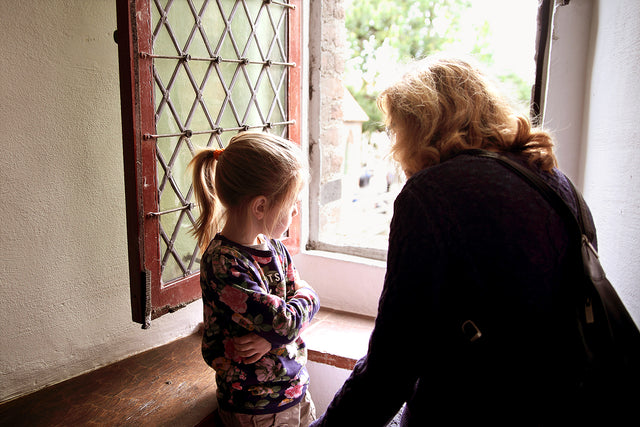3 Toddler Behaviors You Must Stop...Fast

All toddlers do “bad” things…sometimes. But there’s an important differentiation between behaviors that simply annoy us (these are what I call yellow-light behaviors, and they include acts like dawdling and whining) and what I call red-light behaviors.
3 “Bad” Toddler Behaviors to Stop ASAP
There are three types of bad behaviors that go beyond the “annoying” category and need to be stopped in their tracks:
-
Dangerous acts: Running into the street, grabbing hot coffee, playing with knives—any behavior that puts your child (or someone else) in harm’s way.
-
Aggression: Hitting, spitting, kicking, biting, and other mean acts.
-
Breaking key family rules: These are rules you get to choose. Some of them might fit just about all families (like no drawing on the walls), but others vary from home to home, for example: no eating in the living room, no touching the computer, no calling your brother an idiot.
Stopping bad behaviors doesn’t mean rolling up your sleeves and fighting your child mano a mano. Like the world’s top ambassadors, you can stop most conflicts by establishing clear consequences in a respectful manner. The first step is to understand where your tot is coming from.
Why Good Toddlers Behave Badly Sometimes
It’s hard to be good all the time...even for adults! No wonder our little tykes have days when their impulsive, primitive nature takes control and makes them do things they shouldn’t. Here are some of the reasons why good kids do bad things:
-
Toddlers can’t explore without testing the rules. Your tot is an ace explorer—persistent and gutsy. His job is to touch, bang, and pull everything. That’s annoying to you because it makes him constantly push the limits. However, from his point of view, you’re the irritating one because you’re trying to stop his greatest joy—discovery.
-
Toddlers are impulsive. You can’t expect an 18-month-old, or even a 3-year-old, to use good judgment (like not eating medicine or holding hands in a parking lot). Toddlers live in the “now,” and their immature brains don’t focus much on the consequences.
-
Our threats paint kids into a corner. Trying to force defiant tykes to obey often backfires. Our pressure makes them feel painted into a corner, unable to give in without feeling humiliated. That’s why threats often trigger more defiance (and hurt the relationship we work so hard to build), especially in toddlers who are temperamentally challenging and stubborn to begin with.
-
Our limits are inconsistent and confusing. Mushy limits invite kids to push against them. (Your child thinks, Sometimes this is allowed and sometimes not. Let’s see if I can do it now.) They get especially confused when our limits make no sense...to them: What? I love jumping on the sofa more than anything in the world—and you want to stop me? Don’t you love me anymore?
-
Our rules are unrealistic. Many toddlers act out if our expectations are too high. Would you demand good table manners from a 6-month-old? Of course not! Well, similarly, it’s unrealistic to expect an 18-month-old to share, a 2-year-old to never lie, or a 3-year-old to sit still in church.
-
Toddlers are overexposed to aggression. Little kids love to imitate, and that includes bad stuff like shouting and hitting. Make it your job to protect your child from seeing violence on TV, in your community, and between the members of your family.
-
Toddlers have too many stresses. Stress can turn a kind kid into a cave-kid. When your child is acting up, ask yourself: Is my child hungry? Bored? Tired? Overloaded with new rules? Sick? Teething? Surrounded by temptations? Cooped up? Wild from something in his diet (soda/sugar/decongestants)? Jealous? Are there extra stresses at home (new baby, new sitter)?
-
You’re giving too little play and attention. Busy parents accidentally teach their little ones to be defiant or disrespectful by ignoring them when they are good. Thomas Gordon in his book Parent Effectiveness Training calls this the Law of the Soggy Potato Chip (just as kids would rather have soggy potato chips than none at all, toddlers would rather be yelled at than ignored).
How to Stop “Bad” Toddler Behavior
All three of the red-light behaviors demand swift actions, often with a “take-charge” consequence: time-out or giving a fine.
If you’ve set clear limits, but your primitive little buddy is still plowing right through them, you must either fix the problem that’s making your child so ornery or back up your words with a clear negative consequence: punishment.
Punishment is merely a negative response that tells a child when she has crossed a boundary. In truth, it’s your responsibility to take control of her behavior when she is unable (too upset or too mischievous) to respect your rules. Remember, this is not something you are doing to your child; she is the one who’s bringing the consequences upon herself.
When we respectfully reward good acts and quickly put a stop to bad behavior, our children learn the rules…fast!